
Scorpius is a zodiac constellation located in the Southern celestial hemisphere, where it sits near the center of the Milky Way, between Libra to the west and Sagittarius to the east. Scorpius is an ancient constellation that pre-dates the Greeks; it is one of the 48 constellations identified by the Greek astronomer Ptolemy in the second century. Its old astronomical symbol is (♏︎).
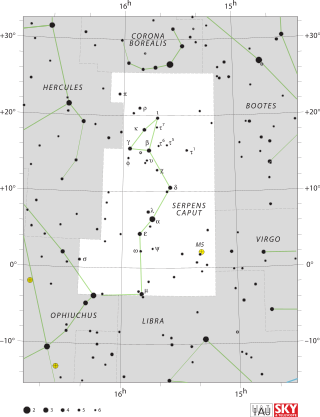
Serpens is a constellation in the northern celestial hemisphere. One of the 48 constellations listed by the 2nd-century astronomer Ptolemy, it remains one of the 88 modern constellations designated by the International Astronomical Union. It is unique among the modern constellations in being split into two non-contiguous parts, Serpens Caput to the west and Serpens Cauda to the east. Between these two halves lies the constellation of Ophiuchus, the "Serpent-Bearer". In figurative representations, the body of the serpent is represented as passing behind Ophiuchus between Mu Serpentis in Serpens Caput and Nu Serpentis in Serpens Cauda.

Messier 14 is a globular cluster of stars in the constellation Ophiuchus. It was discovered by Charles Messier in 1764.

Messier 5 or M5 is a globular cluster in the constellation Serpens. It was discovered by Gottfried Kirch in 1702.

Messier 3 is a globular cluster of stars in the northern constellation of Canes Venatici.
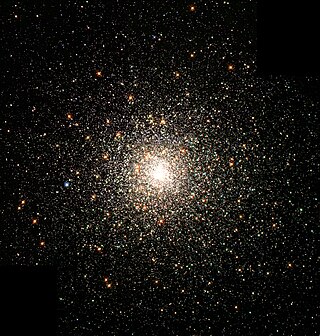
Messier 80 is a globular cluster in the constellation Scorpius. It was discovered by Charles Messier in 1781, being one of his first discoveries.

Messier 15 or M15 is a globular cluster in the constellation Pegasus. It was discovered by Jean-Dominique Maraldi in 1746 and included in Charles Messier's catalogue of comet-like objects in 1764. At an estimated 12.5±1.3 billion years old, it is one of the oldest known globular clusters.
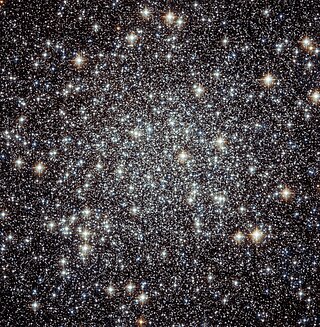
Messier 22 or M22, also known as NGC 6656, is an elliptical globular cluster of stars in the constellation Sagittarius, near the Galactic bulge region. It is one of the brightest globulars visible in the night sky. The brightest stars are 11th magnitude, with hundreds of stars bright enough to resolve with an 8" telescope. It is just south of the sun's position in mid-December, and northwest of Lambda Sagittarii, the northernmost star of the "Teapot" asterism.

Messier 53 is a globular cluster in the Coma Berenices constellation. It was discovered by Johann Elert Bode in 1775. M53 is one of the more outlying globular clusters, being about 60,000 light-years (18.4 kpc) light-years away from the Galactic Center, and almost the same distance from the Solar System. The cluster has a core radius (rc) of 2.18 pc, a half-light radius (rh) of 5.84 pc, and a tidal radius (rtr) of 239.9 pc.

Messier 55 is a globular cluster in the south of the constellation Sagittarius. It was discovered by Nicolas Louis de Lacaille in 1752 while observing from what today is South Africa. Starting in 1754, Charles Messier made several attempts to find this object from Paris but its low declination meant from there it rises daily very little above the horizon, hampering observation. He observed and catalogued it in 1778. The cluster can be seen with 50 mm binoculars; resolving individual stars needs a medium-sized telescope.

Messier 56 is a globular cluster in the constellation Lyra. It was discovered by Charles Messier in 1779. It is angularly found about midway between Albireo and Sulafat. In a good night sky it is tricky to find with large (50–80 mm) binoculars, appearing as a slightly fuzzy star. The cluster can be resolved using a telescope with an aperture of 8 in (20 cm) or larger.

Messier 68 is a globular cluster found in the east south-east of Hydra, away from its precisely equatorial part. It was discovered by Charles Messier in 1780. William Herschel described it as "a beautiful cluster of stars, extremely rich, and so compressed that most of the stars are blended together". His son John noted that it was "all clearly resolved into stars of 12th magnitude, very loose and ragged at the borders".

Messier 70 or M70, also known as NGC 6681, is a globular cluster of stars to be found in the south of Sagittarius. It was discovered by Charles Messier in 1780. The famous comet Hale–Bopp was discovered near this cluster in 1995.

Messier 75 or M75, also known as NGC 6864, is a giant globular cluster of stars in the southern constellation Sagittarius. It was discovered by Pierre Méchain in 1780 and included in Charles Messier's catalog of comet-like objects that same year.

Messier 92 is a globular cluster of stars in the northern constellation of Hercules.

V1280 Scorpii is the first of two novae that occurred in the constellation Scorpius during February 2007. Announced by the IAU in Electronic Telegram No. 835 and Circular No. 8803, the nova's magnitude was 9.6 when it was discovered on CCD images taken at 20:42 UT on 4 February 2007 by Yuji Nakamura of Kameyama, Mie, Japan. It was independently discovered on the same night at 20:30 UT by Yukio Sakurai of Mito, Ibaraki, Japan. It peaked at magnitude 3.79 on February 17, making it easily visible to the naked eye. V1280 Scorpii is two degrees south of M62.
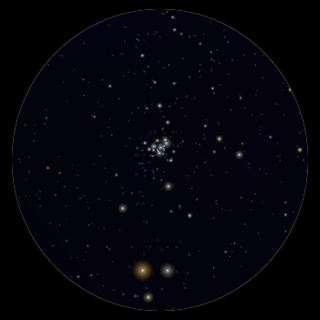
Zeta2 Scorpii is a K-type orange giant star in the constellation of Scorpius. It has an apparent visual magnitude which varies between 3.59 and 3.65, and is located near the blue-white supergiant star ζ1 Scorpii in Earth's sky. In astronomical terms, ζ2 is much closer to the Sun and unrelated to ζ1 except for line-of sight co-incidence. ζ1 is 5,700 light-years away and probably an outlying member of open star cluster NGC 6231, whereas ζ2 is a mere 132 lightyears distant and thus much less luminous in real terms. ζ2 can also be distinguished from its optical partner, ζ1, because of its orangish colour especially in long-exposure astrophotographs.
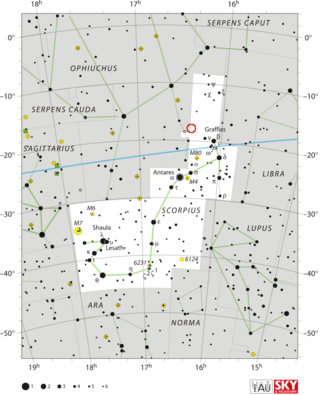
U Scorpii is a recurrent nova system; one of 10 known recurring novae in the Milky Way galaxy. Located near the northern edge of the constellation Scorpius it normally has a magnitude of 18, but reaches a magnitude of about 8 during outbursts. Outbursts have been observed in 1863, 1906, 1936, 1979, 1987, 1999, 2010, and 2022.

V1073 Scorpii is a variable star in the constellation Scorpius. It has a non-Greek Bayer designation of k Scorpii. The star has a blue-white hue and is visible to the naked eye with an apparent visual magnitude that fluctuates around +4.87. Parallax measurements yield a distance estimate of approximately 2,920 ly (896 pc) from the Sun, and it is drifting further away with a radial velocity of +7 km/s. It has an absolute magnitude of −6.8
V1309 Scorpii is a contact binary that merged into a single star in 2008 in a process known as a luminous red nova. It was the first star to provide conclusive evidence that contact binary systems end their evolution in a stellar merger. Its similarities to V838 Monocerotis and V4332 Sagittarii allowed scientists to identify these stars as merged contact binaries as well.




















